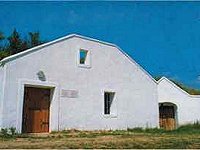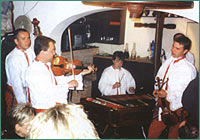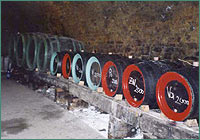


| TSD 2004 Proceedings | O | Invited Speakers | O | TSD 2004 Program | O | Conference Trip | O | Available Equipment | 
|
The Friday afternoon of the conference is reserved for a trip to one of the historical towns in the South Moravia - the town of Znojmo
A city of just under 40,000, Znojmo is the cultural and economic center of bountiful farmland of Southwest Moravia. The site of an important castle during the Great Moravian Empire, the area was the site of a fortified settlement known as St. Hippolyte by the 9th century and has been settled since the 6th century, when the Slavs came from the southeast. Located on the River Dyje, Znojmo is well known for its wine and its cucumbers, which were brought to the area from Hungary in 1571.After the Great Moravian Empire fell apart in the 11th century, the villages in the area banded together around the castle and a church, the Rotunda of the Virgin Mary, and formed a principality. When Moravia was joined to Bohemia under the Premyslids, the villages were joined into the town of Znojmo, which was raised to the status of a royal town by King Premysl Otakar I in 1226. With the end of the Premyslid line at the beginning of the 14th century, Znojmo was witness to a number of the negotiations in which first the Hapsburgs of Austria laid claim to the Czech throne, and then when it was taken by John of Luxembourg, he bestowed a number of royal privileges on the city. The increasing fortification of Znojmo from the 14th to the 16th century is still in evidence today in the city's old town. In 1628, after the Battle of White Mountain (Bila hora), Znojmo was once again witness to a Hapsburg move on the Czech throne, but this time the national constitutional congress was merely a legalization of the Hapsburgs' hereditary claim to the Czech throne and the re-Catholicization and Germanization of the Czech Lands. The city was a battle site in the Thirty Years' War, and then again during the wars between Austria and Prussia and the Napoleonic Wars, and didn't really develop further until the 19th century, when imperial roads connected it to trade routes through Vienna, Brno and Prague. The city's historical center, with its medieval fortifications, castle, churches of St. Nicholas and St. Michael, and various monasteries and chapels, was declared an urban landmark preserve in 1971.
We will walk through the historical center of the town and visit the underground passages
Originally formed from the cellars of townhouses, these passages go four stories deep down into the rock. As they are all interconnected, they form a complicated tunnel labyrinth. This is particularly remarkable for its ventilation and drainage systems, and features a large number of underground springs. In the past, the passages have been used to store argricultural produce, especially fruit and wine. In times of conflict, they could also be used for defense purposes. A stretch of approximately 1km of tunnel is open to the public, and can be accessed from "sleepy tired" square.



In the evening, we will move to a near well known wine cellar of
Satov,
where the conference dinner will be served with a tasting of local
delicious wine. The dinner will be accompanied by
a traditional cembalon band playing.


| 
| 
|